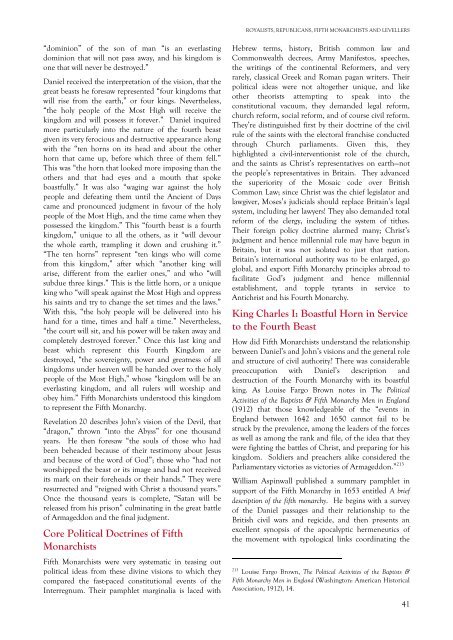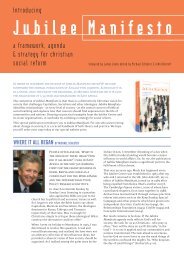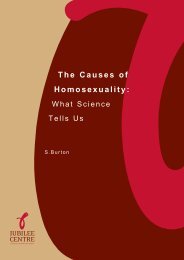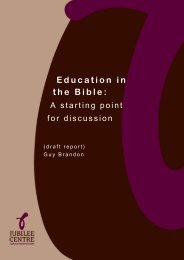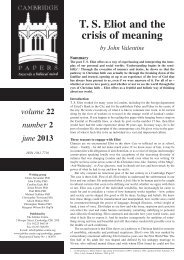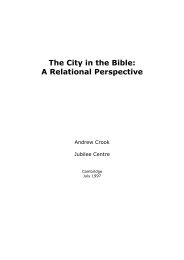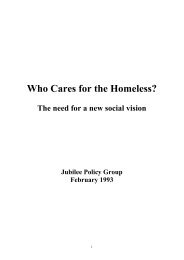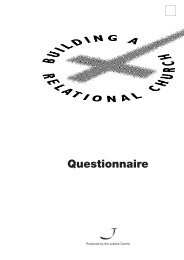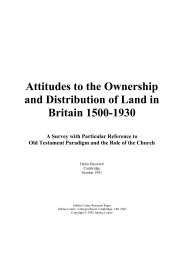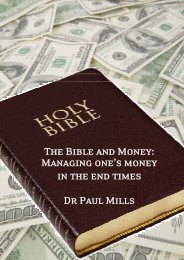Report Template - Jubilee Centre
Report Template - Jubilee Centre
Report Template - Jubilee Centre
You also want an ePaper? Increase the reach of your titles
YUMPU automatically turns print PDFs into web optimized ePapers that Google loves.
ROYALISTS, REPUBLICANS, FIFTH MONARCHISTS AND LEVELLERS<br />
“dominion” of the son of man “is an everlasting<br />
dominion that will not pass away, and his kingdom is<br />
one that will never be destroyed.”<br />
Daniel received the interpretation of the vision, that the<br />
great beasts he foresaw represented “four kingdoms that<br />
will rise from the earth,” or four kings. Nevertheless,<br />
“the holy people of the Most High will receive the<br />
kingdom and will possess it forever.” Daniel inquired<br />
more particularly into the nature of the fourth beast<br />
given its very ferocious and destructive appearance along<br />
with the “ten horns on its head and about the other<br />
horn that came up, before which three of them fell.”<br />
This was “the horn that looked more imposing than the<br />
others and that had eyes and a mouth that spoke<br />
boastfully.” It was also “waging war against the holy<br />
people and defeating them until the Ancient of Days<br />
came and pronounced judgment in favour of the holy<br />
people of the Most High, and the time came when they<br />
possessed the kingdom.” This “fourth beast is a fourth<br />
kingdom,” unique to all the others, as it “will devour<br />
the whole earth, trampling it down and crushing it.”<br />
“The ten horns” represent “ten kings who will come<br />
from this kingdom,” after which “another king will<br />
arise, different from the earlier ones,” and who “will<br />
subdue three kings.” This is the little horn, or a unique<br />
king who “will speak against the Most High and oppress<br />
his saints and try to change the set times and the laws.”<br />
With this, “the holy people will be delivered into his<br />
hand for a time, times and half a time.” Nevertheless,<br />
“the court will sit, and his power will be taken away and<br />
completely destroyed forever.” Once this last king and<br />
beast which represent this Fourth Kingdom are<br />
destroyed, “the sovereignty, power and greatness of all<br />
kingdoms under heaven will be handed over to the holy<br />
people of the Most High,” whose “kingdom will be an<br />
everlasting kingdom, and all rulers will worship and<br />
obey him.” Fifth Monarchists understood this kingdom<br />
to represent the Fifth Monarchy.<br />
Revelation 20 describes John’s vision of the Devil, that<br />
“dragon,” thrown “into the Abyss” for one thousand<br />
years. He then foresaw “the souls of those who had<br />
been beheaded because of their testimony about Jesus<br />
and because of the word of God”; those who “had not<br />
worshipped the beast or its image and had not received<br />
its mark on their foreheads or their hands.” They were<br />
resurrected and “reigned with Christ a thousand years.”<br />
Once the thousand years is complete, “Satan will be<br />
released from his prison” culminating in the great battle<br />
of Armageddon and the final judgment.<br />
Core Political Doctrines of Fifth<br />
Monarchists<br />
Fifth Monarchists were very systematic in teasing out<br />
political ideas from these divine visions to which they<br />
compared the fast-paced constitutional events of the<br />
Interregnum. Their pamphlet marginalia is laced with<br />
Hebrew terms, history, British common law and<br />
Commonwealth decrees, Army Manifestos, speeches,<br />
the writings of the continental Reformers, and very<br />
rarely, classical Greek and Roman pagan writers. Their<br />
political ideas were not altogether unique, and like<br />
other theorists attempting to speak into the<br />
constitutional vacuum, they demanded legal reform,<br />
church reform, social reform, and of course civil reform.<br />
They’re distinguished first by their doctrine of the civil<br />
rule of the saints with the electoral franchise conducted<br />
through Church parliaments. Given this, they<br />
highlighted a civil-interventionist role of the church,<br />
and the saints as Christ’s representatives on earth—not<br />
the people’s representatives in Britain. They advanced<br />
the superiority of the Mosaic code over British<br />
Common Law; since Christ was the chief legislator and<br />
lawgiver, Moses’s judicials should replace Britain’s legal<br />
system, including her lawyers! They also demanded total<br />
reform of the clergy, including the system of tithes.<br />
Their foreign policy doctrine alarmed many; Christ’s<br />
judgment and hence millennial rule may have begun in<br />
Britain, but it was not isolated to just that nation.<br />
Britain’s international authority was to be enlarged, go<br />
global, and export Fifth Monarchy principles abroad to<br />
facilitate God’s judgment and hence millennial<br />
establishment, and topple tyrants in service to<br />
Antichrist and his Fourth Monarchy.<br />
King Charles I: Boastful Horn in Service<br />
to the Fourth Beast<br />
How did Fifth Monarchists understand the relationship<br />
between Daniel’s and John’s visions and the general role<br />
and structure of civil authority? There was considerable<br />
preoccupation with Daniel’s description and<br />
destruction of the Fourth Monarchy with its boastful<br />
king. As Louise Fargo Brown notes in The Political<br />
Activities of the Baptists & Fifth Monarchy Men in England<br />
(1912) that those knowledgeable of the “events in<br />
England between 1642 and 1650 cannot fail to be<br />
struck by the prevalence, among the leaders of the forces<br />
as well as among the rank and file, of the idea that they<br />
were fighting the battles of Christ, and preparing for his<br />
kingdom. Soldiers and preachers alike considered the<br />
Parliamentary victories as victories of Armageddon.” 213<br />
William Aspinwall published a summary pamphlet in<br />
support of the Fifth Monarchy in 1653 entitled A brief<br />
description of the fifth monarchy. He begins with a survey<br />
of the Daniel passages and their relationship to the<br />
British civil wars and regicide, and then presents an<br />
excellent synopsis of the apocalyptic hermeneutics of<br />
the movement with typological links coordinating the<br />
213<br />
Louise Fargo Brown, The Political Activities of the Baptists &<br />
Fifth Monarchy Men in England (Washington: American Historical<br />
Association, 1912), 14.<br />
41


